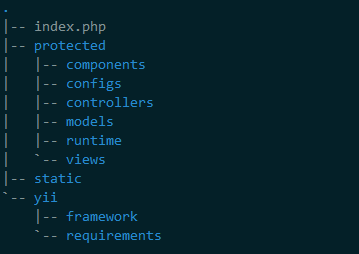2014-11-04 二
By youngsterxyf对于Web框架,我认为其主要有三点作用:
- 提供多人协作的基本规范
- 避免重复造轮子
- 开发者只需关注业务逻辑,脏活(如:基本的安全防范、兼容问题)Web框架都已完成并提供设计良好的API
但代价是学习成本 - 为了尽可能发挥Web框架的优势,需要花一些阅读文档,甚至是框架源码(特别是文档缺乏或者文档写得垃圾的),然后经过几次项目实践,一切才能了然于胸。
喏,为了在工作中更好地使用、避免误用Yii框架,大致阅读了Yii框架的部分代码,然后有了这个系列的笔记。
深入学习一个Web框架,首先要理解的是请求处理流程。对于PHP而言,处理流程也即包含了应用的初始化过程,如加载配置、初始化组件等。请求处理流程中最核心的应该是路由解析和分发,此外可能还有过滤器处理、事件处理等,直到请求处理进入具体的Controller和Action。响应生成、过滤等也可以关注。
基于Yii框架的工程目录结构大致如下所示:

- index.php是应用的入口
- protected目录是存放动态脚本的地方static目录存放静态文件,如CSS、JS、图片等
- components子目录存放各种组件类
- configs存放应用的配置文件
- controllers存放Controller类文件
- models存放Model类文件
- runtime存放一些应用生成的临时文件或者缓存文件,如Smarty编译好的模板、日志文件
- views存放View模板文件
- yii目录则存放Yii框架的源码
index.php文件的内容大致如下:
<?php
defined('APP_ENV') or define('APP_ENV', 'development'); if (APP_ENV == 'production') { ini_set('display_errors', 0); error_reporting(E_ALL); define('YII_ENABLE_ERROR_HANDLER', false); $yii = dirname(__FILE__) . '/yii/framework/yiilite.php'; defined('YII_TRACE_LEVEL') or define('YII_TRACE_LEVEL', 1); } else { error_reporting(E_ALL); $yii = dirname(__FILE__) . '/yii/framework/yii.php'; defined('YII_DEBUG') or define('YII_DEBUG', true); defined('YII_TRACE_LEVEL') or define('YII_TRACE_LEVEL', 3); } $config = dirname(__FILE__) . '/protected/configs/' . APP_ENV . '.php'; require_once($yii); $YiiApp = Yii::createWebApplication($config); $YiiApp->run();
根据应用所处的环境(开发环境或生产环境)配置不同的环境变量,加载不同的配置文件,然后根据配置信息创建一个Web应用对象(这个对象类似一个容器),并处理请求。
Yii::createWebApplication($config)中类Yii直接继承自类YiiBase,并且没有自定义属性和方法,即调用的静态方法createWebApplication来自类YiiBase,实现如下:
public static function createWebApplication($config=null)
{
return self::createApplication('CWebApplication', $config);
}
之所以这么实现,是因为Yii还支持控制台/命令行类型的应用实现,比如cron脚本。
静态方法createApplication实现如下:
public static function createApplication($class, $config=null)
{
return new $class($config);
}
真正实例化的类CWebApplication见文件yii/framework/web/CWebApplication.php。
类CWebApplication自己也没有实现构造方法,直接继承自抽象类CApplication(见文件yii/framework/base/CApplication.php),其构造方法实现如下:
public function __construct($config=null)
{
Yii::setApplication($this);
// set basePath at early as possible to avoid trouble
if(is_string($config))
$config=require($config); if(isset($config['basePath'])) { $this->setBasePath($config['basePath']); unset($config['basePath']); } else $this->setBasePath('protected'); Yii::setPathOfAlias('application',$this->getBasePath()); Yii::setPathOfAlias('webroot',dirname($_SERVER['SCRIPT_FILENAME'])); if(isset($config['extensionPath'])) { $this->setExtensionPath($config['extensionPath']); unset($config['extensionPath']); } else Yii::setPathOfAlias('ext',$this->getBasePath().DIRECTORY_SEPARATOR.'extensions'); if(isset($config['aliases'])) { $this->setAliases($config['aliases']); unset($config['aliases']); } $this->preinit(); $this->initSystemHandlers(); $this->registerCoreComponents(); $this->configure($config); $this->attachBehaviors($this->behaviors); $this->preloadComponents(); $this->init(); }
Yii::setApplication($this)将当前类CWebApplication的实例化对象赋值给类YiiBase的私有属性$_app,之后通过Yii::app()就能取到这个对象(app方法其实是类YiiBase中定义的)。
构造方法根据配置信息初始化一些路径和别名相关的属性。以路径别名application为例,如果想将日志目录配置为protected/runtime,则可以指定路径为application.runtime,这样的好处是你可以配置basePath来指定动态脚本所在的目录,不一定必须是protected,即使你的修改了basePath,其余相对basePath的路径配置都不需要变动。
类CApplication又直接继承自类CModule(见文件yii/framework/base/CModule.php),上述构造方法中调用的方法preinit、configure、preloadComponents定义在类CModule中。
preinit的方法体为空。这个方法调用之后主要是加载核心组件、及将配置信息存到Yii::app()这个容器对象中。如果需要在这些操作之前做一些初始化准备工作,则可以自定义一个类继承自类CWebApplication,然后实现preinit方法。但这样的话,index.php中创建web应用对象的方式就有所不同的了,假设自定义的类为MyWebApplication,index.php中在引入该类文件后:
$yiiApp = Yii::createApplication('MyWebApplication', $config);
$yiiApp->run();
方法initSystemHandler则是根据条件设置框架的异常和错误处理方法。
方法registerCoreComponents则是加载框架的核心组件,当然如果有需要可以配置同名(同名指的是key相同,Yii中每个组件都是通过一个key或者说别名来注册和引用)的自定义组件来覆盖默认的核心组件,如db、urlManager。
组件的注册加载细节我们会另外写一篇文章来介绍。
方法configure定义在类CModule中,实现如下:
public function configure($config)
{
if(is_array($config))
{
foreach($config as $key=>$value)
$this->$key=$value; } }
看起来是不是很简单?但其实没你想的那么简单呢... 思考一下如果代码中当前对象$this不存在属性$key或者名为$key的属性是私有的会发生什么事情?这时PHP的魔术方法__set就派上用场了。
类CModule直接继承自类CComponent。在类CComponent中定义了方法__set,实现如下:
public function __set($name,$value)
{
$setter='set'.$name;
if(method_exists($this,$setter))
return $this->$setter($value);
elseif(strncasecmp($name,'on',2)===0 && method_exists($this,$name)) { // duplicating getEventHandlers() here for performance $name=strtolower($name); if(!isset($this->_e[$name])) $this->_e[$name]=new CList; return $this->_e[$name]->add($value); } elseif(is_array($this->_m)) { foreach($this->_m as $object) { if($object->getEnabled() && (property_exists($object,$name) || $object->canSetProperty($name))) return $object->$name=$value; } } if(method_exists($this,'get'.$name)) throw new CException(Yii::t('yii','Property "{class}.{property}" is read only.', array('{class}'=>get_class($this), '{property}'=>$name))); else throw new CException(Yii::t('yii','Property "{class}.{property}" is not defined.', array('{class}'=>get_class($this), '{property}'=>$name))); }
PHP中对一个对象的属性进行赋值的规则如下:
- 如果该对象有public的该属性,则直接赋值
- 否则看该对象所在继承树上是否有定义魔术方法
__set,如果有则调用__set来处理赋值过程 - 如果连
__set也没有,则为该对象生成一个public的属性,然后赋值给它
类CComponent中定义的魔术方法__set其逻辑是:
- 查看当前对象是否有名为
'set'.$key的方法,如果有,则以该方法来处理赋值过程 - 否则,检查$key是否以字符串
on开头,如果是且当前对象具有名为$key的方法,则认为这是一个事件的赋值过程,将赋值到事件列表中 - 否则,则认为这是一个行为(behavior)赋值,尝试为属性
_m对象列表中对象的属性赋值。(貌似是这样,我也还懂_m的作用)
以上述规则逻辑,所以类CModule中定义了很多方法名以字符串set或get开头的方法,如setComponents、getComponents、setParams、getParams等。说到这里,你是不是领会到什么了?
$this->attachBehaviors($this->behaviors)一句中当前对象的属性behaviors的访问权限为public,默认值为空数组,可以在配置文件中配置如下一项:
'behaviors' => array(
'behaviorName'=>array(
'class'=>'path.to.BehaviorClass',
'property1'=>'value1',
'property2'=>'value2',
) ),
按照上述对象属性的赋值规则,该配置项会赋值给属性behaviors。
方法attachBehaviors对这些配置项逐个初始化然后存入属性_m中。
方法preloadComponents定义在类CModule中,实现如下:
/**
* Loads static application components.
*/
protected function preloadComponents()
{
foreach($this->preload as $id) $this->getComponent($id); }
其中属性preload访问权限为public,默认也是空数组,可以在其中配置需要预加载的组件的ID。
$this->init()一行中方法init定义在类CWebApplication中,实现如下:
protected function init()
{
parent::init();
// preload 'request' so that it has chance to respond to onBeginRequest event.
$this->getRequest();
}
其中方法getRequest就是预加载request组件。
index.php中得到Web应用对象后继而调用其方法run,该run方法定义于类CApplication中,实现如下:
/**
* Runs the application.
* This method loads static application components. Derived classes usually overrides this
* method to do more application-specific tasks.
* Remember to call the parent implementation so that static application components are loaded.
*/ public function run() { if($this->hasEventHandler('onBeginRequest')) $this->onBeginRequest(new CEvent($this)); // 这里为了处理程序主动调用exit()或者抛出异常时的情况 register_shutdown_function(array($this,'end'),0,false); // 请求处理 $this->processRequest(); if($this->hasEventHandler('onEndRequest')) $this->onEndRequest(new CEvent($this)); }
其中方法processRequest定义于类CWebApplication中,实现如下:
public function processRequest()
{
// 可以在配置文件里配置request组件时,提供catchAllRequest参数
// catchAllRequest是一个数组,第一个元素指定一个controller及一个action,其余元素是这个action的参数
// 如果配置了catchAllRequest,就可以用这个controller/action来处理所有的请求,当网站进入维护状态时,有其用处。
if(is_array($this->catchAllRequest) && isset($this->catchAllRequest[0])) { $route=$this->catchAllRequest[0]; foreach(array_splice($this->catchAllRequest,1) as $name=>$value) $_GET[$name]=$value; } else // 正常的路由解析 // 组件urlManager ->parseUrl 组件request $route=$this->getUrlManager()->parseUrl($this->getRequest()); // 根据路由执行控制器处理函数 $this->runController($route); }
其中路由解析的过程我们也会以单独的一篇文章来分析,暂不细说。
方法runController的实现如下:
/**
* Creates the controller and performs the specified action.
* @param string $route the route of the current request. See {@link createController} for more details.
* @throws CHttpException if the controller could not be created.
*/
public function runController($route) { if(($ca=$this->createController($route))!==null) { list($controller,$actionID)=$ca; $oldController=$this->_controller; $this->_controller=$controller; $controller->init(); $controller->run($actionID); $this->_controller=$oldController; } else throw new CHttpException(404,Yii::t('yii','Unable to resolve the request "{route}".', array('{route}'=>$route===''?$this->defaultController:$route))); }
其中方法createController根据$route按照一定的规则找到对应的controller类,之后调用controller的init方法和run方法。但这个调用之前和之后还恢复老的controller,这应该是因为在一个controller中可以forward到另一个controller中去,也即controller可以递归执行,所以需要保存和恢复上下文。
Yii中所有Controller类都必须直接或间接继承自类CController,该类的init方法实现为空,如有需要可以在子类中重写。而其run方法实现如下:
public function run($actionID)
{
if(($action=$this->createAction($actionID))!==null)
{
if(($parent=$this->getModule())===null)
$parent=Yii::app(); if($parent->beforeControllerAction($this,$action)) { $this->runActionWithFilters($action,$this->filters()); $parent->afterControllerAction($this,$action); } } else $this->missingAction($actionID); }
$this->runActionWithFilters($action,$this->filters())一行中,方法filters的实现仅是返回一个空数组,如果想要使用过滤器就需要在自定义的Controller类中重写该方法,过滤器的配置方法见源码中注释:
* For a method-based filter (called inline filter), it is specified as 'FilterName[ +|- Action1, Action2, ...]',
* where the '+' ('-') operators describe which actions should be (should not be) applied with the filter.
*
* For a class-based filter, it is specified as an array like the following:
* <pre>
* array(
* 'FilterClass[ +|- Action1, Action2, ...]',
* 'name1'=>'value1',
* 'name2'=>'value2',
* ...
* )
* </pre>
* where the name-value pairs will be used to initialize the properties of the filter.
方法runActionWithFilters实现如下:
public function runActionWithFilters($action,$filters)
{
if(empty($filters))
$this->runAction($action);
else
{ $priorAction=$this->_action; $this->_action=$action; CFilterChain::create($this,$action,$filters)->run(); $this->_action=$priorAction; } }
如果没有设置过滤器,则直接执行目标action,方法runAction的实现如下:
public function runAction($action)
{
$priorAction=$this->_action;
$this->_action=$action;
if($this->beforeAction($action))
{ if($action->runWithParams($this->getActionParams())===false) $this->invalidActionParams($action); else $this->afterAction($action); } $this->_action=$priorAction; }
类CController中定义的beforeAction直接返回true,如果需要在目标action执行之前做一些检查过滤操作则需要在自定义的Controller类中重写beforeAction方法,该方法最后必须返回true或false。beforeAction的作用类似于简化版的过滤器。
beforeAction通过后,则执行目标action。由于路由配置是类正则的,URL解析出来的一些片段值(算是放在url中的请求参数)应该传入目标action,方法getActionParams即是取到这些参数值。Yii在路由解析时将这些参数值也存放到全局变量$_GET中,所以getActionParams直接返回了$_GET。
如果设置了过滤器,则需要根据controller、action、filters创建一个CFilterChain对象(过程中当然会对过滤器配置进行解析),类CFilterChain的run方法实现如下:
public function run()
{
if($this->offsetExists($this->filterIndex))
{
$filter=$this->itemAt($this->filterIndex++);
Yii::trace('Running filter '.($filter instanceof CInlineFilter ? get_class($this->controller).'.filter'.$filter->name.'()':get_class($filter).'.filter()'),'system.web.filters.CFilterChain'); $filter->filter($this); } else $this->controller->runAction($this->action); }
其中$this->filterIndex的初始值为0,方法offsetExits定义于类CList中,逻辑就是检测是否遍历执行完所有的过滤器,如果还有,则取出一个过滤器对象,执行其filter方法,该方法的实现如下:
public function filter($filterChain)
{
$method='filter'.$this->name;
$filterChain->controller->$method($filterChain);
}
这个时候你应该感到疑惑 - 既然是一个过滤器链,那么循环在哪?事实上,Yii的这个地方并没有提供循环来让过滤器逐个执行,这就意味着在自定义的过滤器中,如果过滤条件通过,则需要尾递归地显式调用过滤器链的run方法,这样直到所有的过滤器都通过,才执行目标action$this->controller->runAction($this->action)。
- 2014-12-18 补充:
类YiiBase的方法createApplication:
public static function createApplication($class, $config=null)
{
return new $class($config);
}
是如何找到$class代表的类(CWebApplication或CConsoleApplication类)的呢?类文件yii/framework/YiiBase.php的倒数第二行代码为:
spl_autoload_register(array('YiiBase','autoload'));
当类文件yii/framework/yii.php中 require YiiBase类文件时就执行了这句代码。




 本文详细阐述了使用Yii框架构建应用时的核心工作流程,包括请求处理、初始化、配置加载、组件注册、过滤器和控制器执行等关键步骤,旨在帮助开发者更高效地利用Yii框架,避免常见陷阱。
本文详细阐述了使用Yii框架构建应用时的核心工作流程,包括请求处理、初始化、配置加载、组件注册、过滤器和控制器执行等关键步骤,旨在帮助开发者更高效地利用Yii框架,避免常见陷阱。
















 1135
1135

 被折叠的 条评论
为什么被折叠?
被折叠的 条评论
为什么被折叠?








